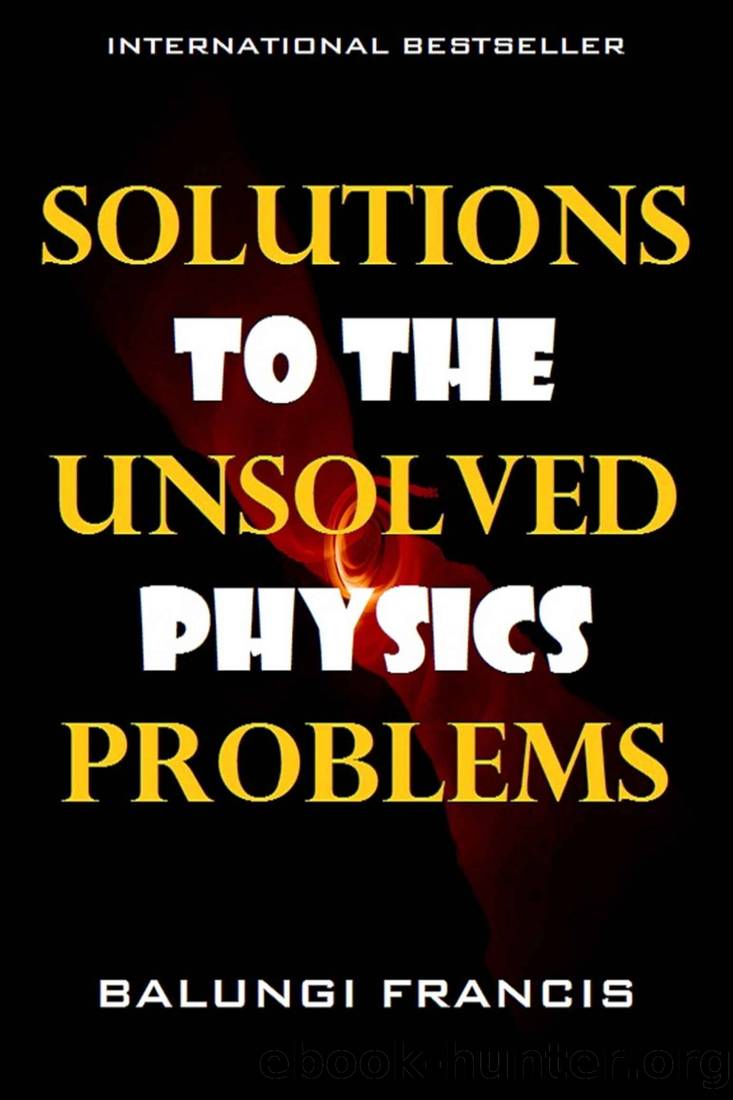Solutions to the Unsolved Physics Problems by Balungi Francis

Author:Balungi Francis [Francis, Balungi]
Language: eng
Format: azw3
Tags: Dark matter, gravity
Publisher: SUSP Science Foundation
Published: 2019-04-13T16:00:00+00:00
10. The Extra Dimension Problem
The big Problem: (i) Is it true that at every spatial dimension, there exists new physics and that it is the work of Physicists to find out? What is the method or procedure through which new physics can be found? Does this require extra dimensions?
(ii) Does nature have more than four space-time dimensions? If so, what is their size? Are dimensions a fundamental property of the universe or an emergent result of other physical laws? Can we experimentally observe evidence of higher spatial dimensions?
(iii) Can the singularities that plague the General theory of Relativity be resolved in any quantum theory of Gravity?
History tells us that if we hit upon some obstacle, even if it looks like a pure formality or just a technical complication, it should be carefully scrutinized. Nature might be telling us something, and we should find out what it is (G. t Hooft, 1997).
In physics, one of the ultimate goals is to unify the fundamental forces of nature. Today physicists have been able to unify three of the four known fundamental forces (the electromagnetic, the strong and the weak nuclear forces in a single quantum field theory-the standard model). The fourth fundamental force, gravity, on the other hand is described by the general theory of relativity. Because the other fundamental interactions are quantized, it therefore seems natural that in a grand unified theory, a theory of all the fundamental forces, gravity is quantized as well into perhaps Quantum gravity.
A theory of quantum gravity is needed to describe things that are very small but also very heavy, like black holes or the early universe. However, the development of a quantum theory of gravity seems difficult on grounds that, in general relativity all physical qualities have definite values, whereas in quantum mechanics they do not as shown in Heisenbergâs uncertainty principle.
The problems in General Relativity arise from trying to deal with a universe that is zero in size (infinite densities). But quantum mechanics suggests that there may be no such thing in nature as a point in space-time, implying that space-time is always smeared out, occupying some minimum region. The minimum smeared-out volume of space-time is a profound property in any quantized theory of gravity and such an outcome lies in a widespread expectation that singularities will be resolved in a quantum theory of gravity.
However, Prof Brian Dolan at the Department of Theoretical Physics, NUI Maynooth, is quick to point out that there is not yet any set agreement on what a theory of quantum gravity should look like, or even on the exact problem it is trying to solve.âThere is no accepted theory of quantum gravity,â he says. âThere are currently a number of contenders, and by far the most popular is superstring theory. Many physicists find superstring theory compelling due to its internal elegance, but despite decades of intense research it has not produced a single experimentally testable result.â He suspects that trying to unite general relativity and quantum mechanics may be the
Download
This site does not store any files on its server. We only index and link to content provided by other sites. Please contact the content providers to delete copyright contents if any and email us, we'll remove relevant links or contents immediately.
Alchemy and Alchemists by C. J. S. Thompson(3294)
The Elements by Theodore Gray(2851)
The Club by A.L. Brooks(2745)
How to Make Your Own Soap by Sally Hornsey(2740)
Drugs Unlimited by Mike Power(2478)
Wheels of Life by Anodea Judith(1917)
Cracking the Sat French Subject Test, 2013-2014 Edition by The Princeton Review(1762)
Perfume by Jean-Claude Ellena(1733)
The Flavor Matrix by James Briscione(1711)
The Cosmic Machine: The Science That Runs Our Universe and the Story Behind It by Scott Bembenek(1693)
Cracking the LSAT, 2012 Edition by Princeton Review(1688)
MCAT Physics and Math Review by Princeton Review(1567)
1000 Multiple-Choice Questions in Organic Chemistry by Organic Chemistry Academy(1565)
Cracking the SAT Premium Edition with 6 Practice Tests, 2017 by Princeton Review(1480)
Handbook of Modern Sensors by Jacob Fraden(1477)
The Thing Around Your Neck by Chimamanda Ngozi Adichie(1476)
A is for Arsenic: The Poisons of Agatha Christie (Bloomsbury Sigma) by Kathryn Harkup(1454)
Synchrotron Light Sources and Free-Electron Lasers by Eberhard J. Jaeschke Shaukat Khan Jochen R. Schneider & Jerome B. Hastings(1454)
Harry Potter All Books: 8 Books by J.k.rowling(1435)
